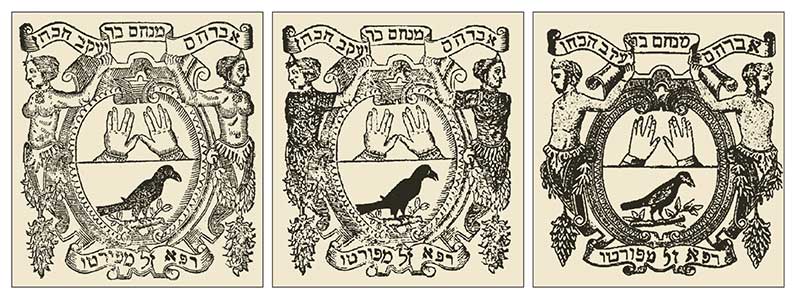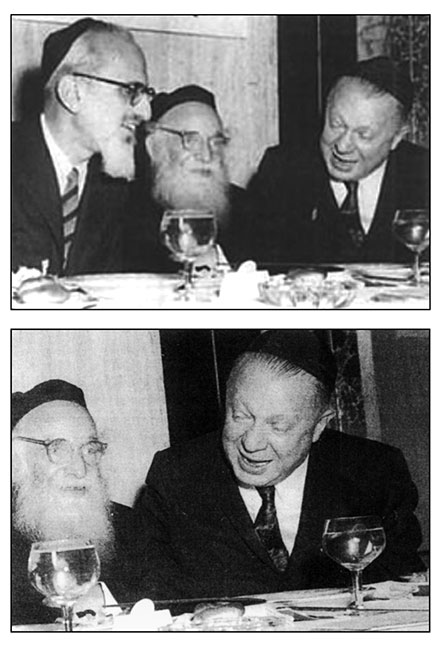Pious Censorship
Some three decades ago, Marc B. Shapiro met a Satmar Hasidic Moykher-Sforim, or book dealer, in the stacks of Harvard’s Widener Library, whose sixth floor houses one of the world’s greatest collections of rabbinic literature. Shapiro, who was a graduate student in Jewish history at the time, was there to study these tomes, while the book dealer had come to reproduce them illegally for sale to haredi customers. They struck up a conversation, and the book dealer showed Shapiro a sample of his work, a republication of an early 20th-century rabbinical halakhic study.
When he opened the book, Shapiro immediately noticed an obvious blank space on one of the book’s first pages where there should have been a haskamah, an approbation from a leading rabbinic authority that is something between a religious Good Housekeeping seal and a literary blurb. Shapiro quickly located the first edition of the book in the Harvard stacks and realized that the approbation the book dealer had expunged was that of the first chief rabbi of the modern-day Land of Israel, Rabbi Abraham Isaac Kook.
I approached the man and told him that I understood that he regarded Kook as a heretic. However, the author of the book thought that Kook was a great man, which is why he had solicited his haskamah.
Shapiro asked for an explanation: “What then gives you the right to take it out?” The Moykher-Sforim replied in all earnestness that the author was now in heaven, and hence undoubtedly knew that the religious Zionist Kook was a heretic, “and he is therefore happy with what I have done.” As Shapiro writes in Changing the Immutable: How Orthodox Judaism Rewrites Its History, as well as in an earlier account of the encounter, this response left him “speechless.” Well, hardly speechless anymore!
In fact, when it comes to unearthing such pious mischief, Shapiro has no peers in either the rabbinic or academic worlds. He has achieved notoriety, in its best sense, as the most persistent and prolific expert on how, as his subtitle has it, Orthodox Judaism rewrites its history. And, precisely because Shapiro is himself a prominent member of the Orthodox community, even his most arcane and scholarly writings generate excitement outside the ivory towers. This is particularly so in the Modern Orthodox community where they are a favored subject among the learned and semi-learned synagogue backbenchers, as well as at rabbinically unsanctioned kiddush clubs worldwide. In such settings, it is not uncommon to find ex-yeshiva students excitedly sharing and debating Shapiro’s latest column on the popular website the Seforim blog.
Shapiro’s remarkably erudite new book delves deeply into the many ways in which Orthodox (mostly haredi) rabbis, “historians,” editors, and publishers have for centuries—but with rapidly increasing alacrity during recent decades—altered, censored, and covered up a vast array of inconvenient historical, halakhic, theological, biographical, and bibliographical realities. As for the Moykher-Sforim’s little act of censorship, Shapiro has now devoted 10 heavily annotated pages to documenting—complete with textual illustrations—the history of the expurgation of dozens of Rav Kook’s haskamot from the front material of many recently reproduced seforim. The authors of these books, among them the greatest Eastern European rabbis of the late 19th and early 20th centuries, may have differed with Rav Kook on the subject of Zionism, but they held him in great esteem and actively sought his approval. For the children, grandchildren, and institutional heirs of these men, this is an embarrassment.
That Shapiro has cast a very large net in fishing for his fishy sources, he makes clear from the outset:
What I am attempting to do in this book is to show how common “instrumental truth” has been, particularly in the last century. My focus is not primarily on works of history, which is where people usually look for this type of information, but rather on all sorts of texts that are the lifeblood of traditional Jewish communities.
Shapiro instructively compares the attitude toward truth he finds in these sources to that of pre-modern historians who provided exemplary narratives for explicitly didactic purposes. “Yet,” he notes, the new “‘Orthodox history’ [. . .] where ‘truth’ was entirely instrumental and what was accepted as fact one day could be entirely rewritten the next,” also bears striking similarities to Soviet historiography.
Although one might have expected Shapiro to open his learned study with the story with which we began, he both opens and closes his book with discussions of a famous and powerful Gentile couple: Hillary and Bill Clinton. No, Shapiro does not concern himself with Hillary’s questionable behavior in concealing and deleting emails written while she served as secretary of state. Rather, he presents, on the very first page of the book’s preface, two photographs of President Barack Obama’s inner circle at the time of the killing of Osama bin Laden. The original photograph very clearly shows Hillary Clinton seated directly across from Vice President Joseph Biden. Directly beneath this image, Shapiro reproduces a clumsily doctored version of the same photo from which Clinton and an unnamed female staffer had been erased, because, well, they are women, and the Yiddish haredi weekly Di Tsaytung doesn’t publish pictures of women.
And then, toward the end of the book’s last and, as it has turned out, rather controversial and I believe widely misunderstood chapter entitled “Is the Truth Really That Important?” Shapiro refers to the single most notorious line of Bill Clinton’s presidency, “I did not have sexual relations with that woman,” as an example of mendaciousness that has historically been most commonly associated with Jesuit casuistry, namely “mental reservation” (in this case, it depends on what one counts as sex). But, as Shapiro (who teaches at a Jesuit institution) shows, there are analogous rabbinical discussions. The range of rabbinic sources he invokes in these few pages is stunning, though here, as elsewhere, one wonders at the principle of selection. Then again, who wouldn’t want to know that the famous Rogatchover Gaon allowed his son-in-law to tell the British authorities that he had been born in Palestine in order to speed up the receipt of his passport—as long as he kept in mind that “the Talmud explains a verse in Psalms to mean that even one who only looks forward to seeing the land of Israel is regarded as if he had been born there”?

Issues of gender and sex are dealt with in great detail in the book’s sixth chapter, entitled “Sexual Matters and More.” Shapiro begins the chapter with a very harsh characterization of the Israeli haredi society’s “extreme fastidiousness when it comes to language that, as far as I know, has no parallels outside this community.” He contends that “someone whose only source of news was the Israeli haredi papers would have never learnt exactly what precipitated Bill Clinton’s impeachment or the resignation and prison sentence of Israel’s President Moshe Katzav.”
Shapiro then somewhat clumsily segues into a fascinating and richly illustrated consideration of the history of internal Orthodox censorship of the title pages of beautiful editions of three of the most authoritative codes of Jewish law: Maimonides’ Mishne Torah, Rabbi Mordechai Jaffe’s Levush Malkhut, and Rabbi Joseph Karo’s Shulchan Arukh. What these stunning frontispieces all share are beautiful renderings of women in various states of undress. All of them have also been altered in later haredi-published editions that replace or simply remove the female figures, or at least their breasts. In another instance, illustrating that such sexually squeamish censorship is nothing new, Shapiro juxtaposes parallel pages from two versions of the Passover haggadah, those of Prague, 1526, and Venice, 1603. In the Prague edition, the words of the haggadah (citing Ezekiel 23:29) that refer to Israel as naked and bare (eirom ve-eryah) are illustrated with a portrait of an almost naked woman and the caption “eirom ve-eryah; eirom bivgadim; ve-eryah be-mitzvot” (naked and bare; naked from clothes; and empty of mitzvot). The more prudish Venice printer not only changed the woman into a man but added a different caption, “tzurat ish, eirom ve-eryah” (the image of a man, naked and empty)!
Although the images with which Shapiro opens are the most arresting pages in this chapter, his detailed discussion of contemporary ultra-Orthodox versions and translations of an array of rabbinical and biblical texts with erotic content is more important and no less disconcerting. Shapiro does not limit his criticisms to ultra-Orthodox translators. He shows numerous examples of prudish 20th-century Modern Orthodox mistranslations, and occasional outright deletions, of sexually charged language in the Soncino translation of the Talmud and Philip Birnbaum’s classic Modern Orthodox edition of the siddur. Still, Shapiro reserves by far his most extensive and scathing comments for the leading American haredi publisher, ArtScroll.
The most extreme example is ArtScroll’s decision to “translate” the Song of Songs by providing an English version of the classic allegorical interpretation of the book. Thus, Shapiro notes the biblical phrase “your two breasts” (Song of Songs 4:5, 7:4) is rendered as “either ‘Moses and Aaron’ or the ‘Tablets of the Law.’” The editors justified such translations by arguing that, “The literal meaning of the words is so far from their meaning, that it is false.’” Shapiro drily notes that this is the first translation of Song of Songs to take such an approach and concludes with the ironic observation that, “As far as I know, no one has ever suggested the publication of an ‘updated’ Hebrew version of the Song of Songs so that Hebrew speakers are not exposed to the original words.”
This is hardly the sole example of Shapiro’s distaste for this particular haredi publisher. In connection with their deletion of the great commentator Rashi’s remark that the early rabbinic sages who engaged in what is known as tikkun sofrim (corrections of the scribes) did actually aim to “reverse” or “correct” the presumably flawed Masoretic biblical text, Shapiro laments:
With ArtScroll now the Bible of choice for so many, it is likely that Rashi’s comment is now unknown to thousands of otherwise learned Jews, and, as with all acts of censorship, that is exactly the point.
Another of Shapiro’s many stinging critiques of the liberties ArtScroll takes with sacred texts is hidden away, in a long and detailed footnote—one of many hundreds of similarly packed annotations—to his brief history of the censorship of the words of Birkat ha-minim, the malediction against sectarians that was added to the daily Amida prayer in the early rabbinical era. Shapiro offers the following withering critique, which merits extensive citation:
In explaining the word velamalshinim (slanderers), and not realizing that the word is not part of the original prayer, the Complete ArtScroll Siddur (ed. Scherman and Zlotowitz), explains that the Sadducees, Boethusians, Essenes, and early Christians “used their political power to oppress observant Jews and to slander them to the anti-Semitic Roman government.” Quite apart from the improper adjective “observant” used to distinguish different kinds of Jews in Second Temple days (as if the Essenes were not observant), or the false claim that the Essenes and early Christians had political power, the prayer was certainly not directed against Sadducees, Boethusians, or Essenes, and no one has ever claimed otherwise.
Since ArtScroll’s siddur and Chumash have, over the last generation, become the editions of choice in the pews of most Orthodox synagogues, Shapiro’s criticisms are far more than merely academic.
ArtScroll is, however, not alone on Shapiro’s hit list of haredi publishers and publications guilty of censorship and deliberate distortions. The Israeli publisher Netzah is the object of much withering criticism for its haredi reinvention of the 19th-century German Orthodox thinker Samson Raphael Hirsch. Shapiro is especially incensed by Netzah’s attempt to cover up Hirsch’s ideology of Torah im derekh eretz, which required the Orthodox to combine the study and observance of Torah with engagement with the modern world. While Shapiro clearly tries to maintain a detached, scholarly posture throughout, his exasperation, even disgust, occasionally get the better of him, as in this instance:
in a passage dealing with Jewish education […] Hirsch’s mention of torah im derekh erets is deleted! Let us not forget that torah im derekh erets was the central value of Hirsch’s life. One can only wonder at the absurdity of trying to keep Hirsch “kosher” by nullifying his entire educational philosophy.
The chapter devoted to Rav Kook is not only the longest in the book; it will no doubt prove the most upsetting to many readers. If Hirsch has been remade by haredi publishers, translators, and historians, Kook has been literally and figuratively erased, and not only by small-time haredi book dealers. Shapiro richly documents how thoroughly and unscrupulously haredi “historians,” memoirists, and editors have attempted to strip Rav Kook of the great stature he enjoyed during his lifetime.
In a similar vein, Shapiro shows that Joseph B. Soloveitchik, the rosh yeshiva of Modern Orthodoxy’s flagship Yeshiva University and arguably the greatest rabbinic authority in American history, has suffered a similar posthumous fate. He juxtaposes two photographs of Rav Soloveitchik’s great haredi colleague Rabbi Aaron Kotler. In one, he is sitting at a dinner, flanked by Rav Soloveitchik and Irving Bunim, a leading figure in the American Agudath Israel movement. In the other, taken from a recent haredi hagiography of Rabbi Kotler, Soloveitchik has been cropped out of the photo.
The chapters entitled “Jewish Thought” and “Halakhah” are exemplary of Shapiro’s book, both its major merits and, alas, its minor flaws. That is to say that both chapters are rich with hitherto unexplored information about censorship and literally bursting with fantastically erudite annotations and asides, but Shapiro sometimes loses his focus. Into the chapter on Jewish thought, for example, he inserts the complex, subtle, and not really relevant issue of Maimonidean esotericism. To the degree that both Maimonides and today’s haredi censors feel entitled to keep certain potentially dangerous truths from the faithful but untutored masses, one might argue that Shapiro’s inclusion of Maimonides’ and other medieval philosophers’ and kabbalists’ theological-political wariness is warranted. But, as Shapiro himself makes clear, there is a significant distinction between those who censor the work of other, mostly deceased, authors and those who choose to exercise care, or restraint, in what they themselves write.

The chapter on halakha also includes a long digression that rather abruptly interrupts the long history of the censorship of lenient rabbinical views regarding drinking Gentile wine, with which the chapter begins and concludes. While speaking of drinking that which is forbidden, Shapiro strays into an entirely tangential and very long discussion of the strange and at times antinomian beliefs and behaviors of a handful of Hasidic rebbes that were eventually censored from their biographies. This train of thought is set in motion by Menachem Mendel of Rymanow who drank—honey syrup, not Gentile wine—on Yom Kippur afternoon because he had a vision in which the heavenly gates had already closed and forgiveness had been granted, so that Yom Kippur was (conveniently) over sometime after mincha. Such extreme, even delusional, grandiosity was rather common among early Hasidic leaders, but it was never meant as a judicial precedent in matters of halakha and was never prescribed for others. This material certainly has no place in a chapter devoted to the attempts to cover up thoroughly reasoned, if controversial, halakhic decisions on the part of leading rabbinical authorities. In fact, Shapiro discusses other Hasidic rebbes’ bizarre, unhalakhic ideas and dramatically antinomian actions in a kind of miscellany entitled “Other Censored Matters” and might better have included the material there.
Shapiro’s discussions of both male and female head coverings are similarly scattered. In a sharp put-down of the extensive effort by contemporary haredi authors and editors to cover up (literally!) the fact that until quite recently many Orthodox women, including the wives of leading rabbis, did not cover their hair, Shapiro writes in his Introduction:
All I would say is that if you are going to start touching up pictures, you have a lot of work ahead of you. For starters, the typical non-hasidic rabbi’s wife in the United States did not even wear a sheitl (wig) until the 1970s or later.
But it turns out that Shapiro does in fact have much more to say on this very subject, in discussions of tzni’ut (female modesty) found in two subsequent chapters. The entire discussion probably belongs in the chapter on halakha, in which Shapiro documents the censorship of a responsum by the great Baghdadi sage Rabbi Joseph Hayim, which concedes that in non-Islamic lands, where women tend to go about with uncovered hair, there is no strict halakhic imperative to cover one’s hair.
Shapiro’s discussion of men’s head coverings, illustrated with a startling gallery of photos of bare-headed prominent rabbis and rebbes, from Rabbi Leon Modena and Rabbi Moses Gentili in the Renaissance era to such modern luminaries as Isaac Breuer and the late Lubavitcher Rebbe, concludes his chapter on Samson Raphael Hirsch, who is not mentioned at all in the final quarter of the chapter. This extensive digression also seems to belong in the chapter on halakha.
Readers of Shapiro’s prodigious and provocative earlier chapters on the deliberate deletions and distortions of history, biography, and theology in the work of contemporary haredi writers will be surprised by his concluding chapter, “Is the Truth Really That Important?” This chapter, which to my knowledge constitutes the fullest English-language collection of rabbinical sources dealing, in some way or another, with issues of truth and falsehood, elicited immediate criticism by those who misread Shapiro as arguing here that, in the end, the value of truth indeed does not matter after all.
It is not difficult to see how Shapiro’s conclusion was misconstrued as justifying, at least from within the framework of classical rabbinic thought, many, although certainly not all, of the egregious examples of censorship that he so meticulously documented in the previous seven chapters. Such a reading, however, distorts his intention. Shapiro is more than sufficiently clear that he is “interested in the strand of Jewish tradition that countenances falsehood,” which he deems “an approach [that] deserves to be understood in a sympathetic manner [. . .] and to be recovered, as it were, from well-intentioned attempts to explain it away.”
Still, the absence of any apparent organizing principle to his extensive discussion, as well as Shapiro’s clumsy phraseology and often simplistic understanding of the many different meanings of “truth” (e.g., ontological, natural, mathematical, logical, emotional, religious, and legal truths), are at least partially to blame for the confused reactions of many readers. What Shapiro is really addressing is not whether the “truth is really important” for the rabbis, which of course it is. It is rather the difficult and ancient question of what truth is; is there always, necessarily, a single truth on any one issue? Can there be conflicting, but parallel and thus equally valid, truths regarding the same subject, especially when it comes to matter of belief or law rather than, say, arithmetic? In its overly wide and unordered array of mostly medieval and early modern rabbinical sources, Shapiro’s discussion is overly parochial (and, I dare say, overly erudite) regarding a complex set of issues that has engaged philosophers since the ancient Greeks. Aside from a reference to Maimonides here and Plato there, Shapiro shows little evidence of having thought deeply about the nature of truth before setting out to write of its significance for the rabbis. Thus, Shapiro never alludes to the truly vast and illuminating literature from analytic philosophers of the last one hundred plus years on truth.
Unfortunately, this combination of academic insularity and overwhelmingly vast knowledge of rabbinical sources has led to some even more parochial exchanges between Shapiro and his critics in venues such as the Seforim blog, most notably with Aryeh Frimer, who seems to have completely misunderstood Shapiro’s intention, which is neither to justify nor to condemn all the mischief that he has documented in this rich study, but rather to make sense of it from the perspective of its perpetrators.
Of course, the fact that in earlier chapters Shapiro often expressed intense frustration and hostility, as well as no small degree of mockery, toward the Orthodox re-writing of history was bound to make his concluding chapter deeply confusing to many readers. Here too, even a brief discussion of standards of truth in different disciplines together with a sketch of the three dominant theories of truth (correspondence, coherence, and pragmatist) could have prevented a good deal of misunderstanding. To be brief, one might argue that the rabbinic tradition has been largely unconcerned with truth as “correspondence” to scientific or historical facts, but rather with promoting those “truths” that cohere with the larger belief system, or serve pragmatically to stabilize the community of believers. Such a discussion would also have shown that differing attitudes to what truth is and what justifies denying or concealing it are hardly unique to the rabbis. Most importantly, it would, no doubt, have left far fewer of Shapiro’s readers scratching their heads after concluding this fascinating and remarkably learned book.
Suggested Reading

Some Calming Words
Hillel Halkin shouldn’t be so worried. Democracy is still alive and kicking in Israel. The Israelis who didn’t vote like him aren’t stupid. They’re no less wise, humanitarian, and upright…

Of Were-Owls and Wandering Jews
There were two Jewish shape-shifters in my Faerie and Zion reading this month.
The Rothschilds of the East
The Splendor of the Camondos and the pity of it all.
Digital Anti-Semitism: From Irony to Ideology
From tweeting trolls to digital incitement, a contemporary history.
Comments
You must log in to comment Log In